Politika Slovenske ljudske stranke nakon sporazuma između Nikole Pašićča i Stjepana Radića 1925.
The Politics of the Slovene People's Party after the Agreement between Nikola Pašić and Stjepan Radić
Author(s): Mateja RatejSubject(s): History
Published by: Hrvatski institut za povijest
Keywords: Slovenian political Catholicism; Anton Korošec; Croat (Republican) Peasant Party; Stjepan Radić; National Radical Party; Nikola Pašić
Summary/Abstract: Between 1923 and 1929, the Slovene People’s Party played an important part in the formation of the political landscape of the Slovenian area as well as the Yugoslavian state as whole. The elections to the National Assembly of 8 February 1925, which witnessed violence on the part of repressive bodies towards the supporters of opposition parties during the electoral campaign, saw the Slovene People’s Party united with the Croat Republican Peasant Party in the Opposition Bloc of national understanding and peasant democracy, because despite good election results they could not impede the National Bloc from taking power. With his joining the Bloc, the leader of the Slovene People’s Party, Anton Korošec, wished to strengthen his negotiating position for his nomination to government at a time when the withdrawal of the Nikola Pašić, the Radical leader who was presenting the major obstacle to a rapprochement of the Slovene People’s Party with the National Radical Party, was expected. After the change in the political direction of the country in the summer of 1925, which was caused by the agreement between Nikola Pašić and Stjepan Radić, the leadership of the Slovene People’s Party abandoned its ideological opposition and began to intensively move toward the National Radical Party: for the successful establishment of local district autonomy, as was envisioned by the constitution, as the basis further negotiations, Vojislav Marinković’s general plan for autonomy was accepted. The first line of attack by the party leadership was to discredit the politics of Stjepan Radić, which brought Anton Korošec closer to Nikola Pašić’s rival in the National Radical Party, Velimir Vukićević. The agreement to form a government between the strongest ruling party and the strongest opposition party in the summer of 1925 reoriented the political relations among all the parties in parliament. Division among the parties concerning the question of revision of the 1921 constitution, which was the basis of the polarization in the Yugoslavian political sphere, recognition of that constitution and the inclusion of Stjepan Radić in the government on 18 November 1925 blurred the positions of the parties on various constitutional issues. As regards the Slovene People’s Party, this resulted in the party trying to bring together under its wing all the Slovenian parties in the so called taxation front, in order to solidify Slovenian political ranks and prevent the penetration of the Croat Peasant Party into Slovenia. The law concerning the uniformity of taxes at the beginning of 1926 became the main concern of the opposition parties in the Kingdom of Serbs, Croats, and Slovenes, which assisted in the interpellation of the Yugoslavian club on the issue of setting uniform taxation rates and easing the tax burden in October of 1925.
Journal: Časopis za suvremenu povijest
- Issue Year: 38/2006
- Issue No: 1
- Page Range: 139-158
- Page Count: 19
- Language: Croatian

